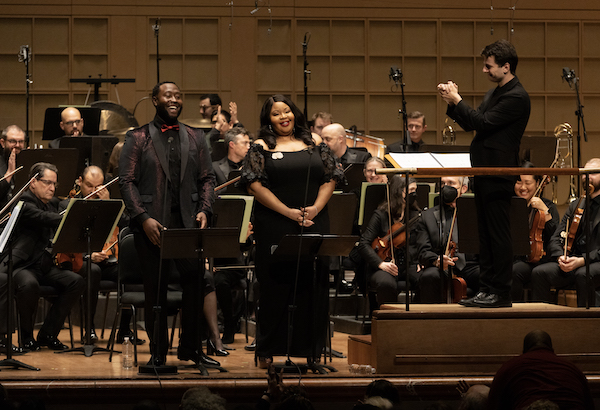Dallas Symphony, soloists deliver a timely program with Blanchard’s “Fire in My Bones”

With Black History Month in full swing, The Dallas Symphony Orchestra’s performance of scenes from Terence Blanchard’s Fire Shut Up In My Bones was a thoughtfully curated and well-executed program presented at the Meyerson Symphony Center Wednesday night.
Complemented by selections of Price and Ellington, it was an offering of cultural appreciation and representation elevated beyond the obligatory and performative nod to black America’s contributions to the canon. Instead, the DSO managed to accomplish what many PWI arts institutions often fail to achieve—the presentation of black culture as rich and diverse in and of itself and the intersectionality of said richness, while championing the fact that black history is still happening.
Florence Price grew up in Little Rock, Arkansas at the turn of the 20th Century. Despite rising to the success of being the first black woman to have her work performed by a major American orchestra, her self-acknowledged “handicaps”—her sex and her race—served to hinder her integration into the mainstream. It wasn’t until 2009, when several of her manuscripts were discovered in an abandoned house in Chicago, that her musical output began to rise to its deserved prominence within the canon.
The program opened with the second movement of Price’s String Quartet in G major, which dates back to 1929 and was arranged for string orchestra in 2020. It is thoroughly Romantic in form and harmonic structure, however, its melodic identity is distinctly black, with the characteristic pentatonic quality of traditional African-American spirituals.
Assistant conductor Maurice Cohn and the DSO managed the material affectionately. The opening themes were replete with lyrical richness and the middle pizzicato passages were dark and buoyant. Here, Cohn’s judicious adherence to time and meter translated to a welcomed balance of rigidity and fluidity.
Duke Ellington’s Harlem was composed in 1950 under a commission by conductor Arturo Toscanini. It was originally planned as part of a grand suite about New York, but when the project broke down, Ellington made it a standalone work.
The DSO revealed an exciting side of itself with this piece, proving its versatility and range of artistry. The piece is a depiction of Harlem’s multicultural richness, touring the listener through layers of social, spiritual, and artistic diversity, and DSO musicians did well to capture the required panoply of tonal colors and textures.
The opening trumpet motif was ruminative and dark, reimagined throughout the work in varying moods by other instruments. The second section featured an array of dance themes and several deftly delivered wind and brass solos by DSO musicians. Cohn’s strict conducting here was looser than the preceding piece—more fluid, interpretive, and full of gusto—leading the ensemble to a vociferous, thrilling finish.
The second half of the program featured selections from Blanchard’s headlined opera Fire Shut Up in My Bones. Guest vocalists soprano Karen Slack and bass-baritone Nicholas Newton joined the DSO in this truncated opera-in-concert performance, complete with supertitles.
The work first premiered in 2019 at the Opera Theatre of Saint Louis. But, when Blanchard’s magnum opus opened the Metropolitan Opera’s 2021-2022 season, it cemented itself in the annals of black history as the first opera by an African-American composer to be performed at the Met since its founding in 1883.
Timing for this programmatic maneuver couldn’t be more serendipitous for the DSO, with the recording of the Met performance—part of the Metropolitan Opera Live in HD film series—claiming the award for Best Opera Recording at the 65th Annual Grammy Awards ceremony Sunday night.
The opera, based on a memoir of the same name by American journalist Charles M. Blow, explores themes of sexual identity, masculinity, and love within the black American community. In it, the protagonist, aptly named Charles, reflects on his life and upbringing, centered on his journey to overcome the trauma of a defining incident of sexual abuse.
Slack and Newton pulled double, even triple, duty depicting the various characters showcased in the selected vignettes. Positioned upstage in front of the orchestra, the prevailing opportunity from Wednesday night’s performance was the balance struck between the orchestra and soloists. Still, it was often difficult to hear solo lines over the dense musical accompaniment.
The vibrancy of Newton’s voice was often lost, most likely due to a bit of over-singing. His diction was clear, intonation clean, and his phrasing lush and expressive, but the vocal color was largely stamped with a matte finish, save for Charles’ final numbers—“Mama, It’s Me” and “I Am What I Am.”
In the snapshot of the opera’s third act, Newton commanded a depth and richness that matched the dramatic demands of the narrative and the equally muscular technique called for by the score.
Slack, who helped debut the opera in the role of Billie, Charles’ mother, turned in splendid renderings that also included Greta, the love of Charles’ young adult life, and the apparitions Destiny and Loneliness, figurative personifications of the concepts for which they’re named.
Her tone was elegant and resplendent as Greta, weathered and warm as Billie, foreboding and eerily light as the foretelling spirits. Again, though her color managed to distinguish itself ably against the imposing orchestra, diction was too often lost in forte moments.
Ultimately, though, the final effect was more than convincing. What came through was the biting, sobering emotional core of Blanchard’s work. Along with Cohn’s attentive conducting, Newton, Slack, and the DSO managed a respectable interpretation of this groundbreaking work, so much so that the Meyerson could seldom contain the hushed gasps, sighs, and moans wrenched from the audience as the work undulated through moments of emotional tension and release.